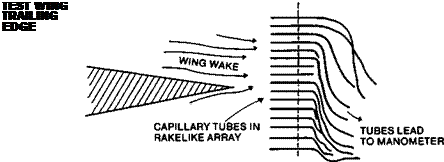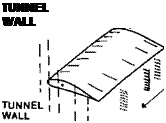DELICACY OF INSTRUMENTATION
The forces on model wings at low speeds are so small that very refined instruments are required to measure them accurately. This is particularly die case with drag. For example, if a test wing is developing a lift force equivalent to a weight of a few grammes, the drag may be a hundredth of this. A wind tunnel balance which can read to only one percent accuracy would be useless. In Schmitz’s tunnel, the model wing under test was suspended on wires in the open sided test section. The forces were found by careful weighing. Most modem tunnels have fully enclosed test sections, which keeps the models free from extraneous disturbances. Various methods are used to measure the forces, many of which do not depend on weighing. The Stuttgart model tunnel, for example, has a series of small holes drilled through the tunnel walls so that the pressure variation of the airstream as it passes round the wing can be accurately measured. This allows the lift to be computed. The drag is measured by a wake rake. This is an array of capillary tubes with open ends, rather like a comb in appearance, which is positioned vertically in the airstream immediately behind the trailing edge of the wing. By measuring the speed of the
 |
Fig. Fig. 10.2 Drag measurement with a wake rake
 |
Typical wake profile

WAKE MUST BE TRAVERSED LATERALLY BECAUSE BOUNDARY LAYER CONTAINS VORTICES WHICH UPSET ISOLATED READINGS
flow at each point the loss of momentum caused by the resistance of the aerofoil can be calculated and, hence, the drag (Figure 10.2). Because of the small vortex flows discovered where separation bubbles occur, the wake rake has to be moved laterally to sample flow across the span of the test model. The final outcome is an average drag coefficient In other wind tunnel laboratories other methods are used, including strain gauges and very sophisticated electronic balances.











